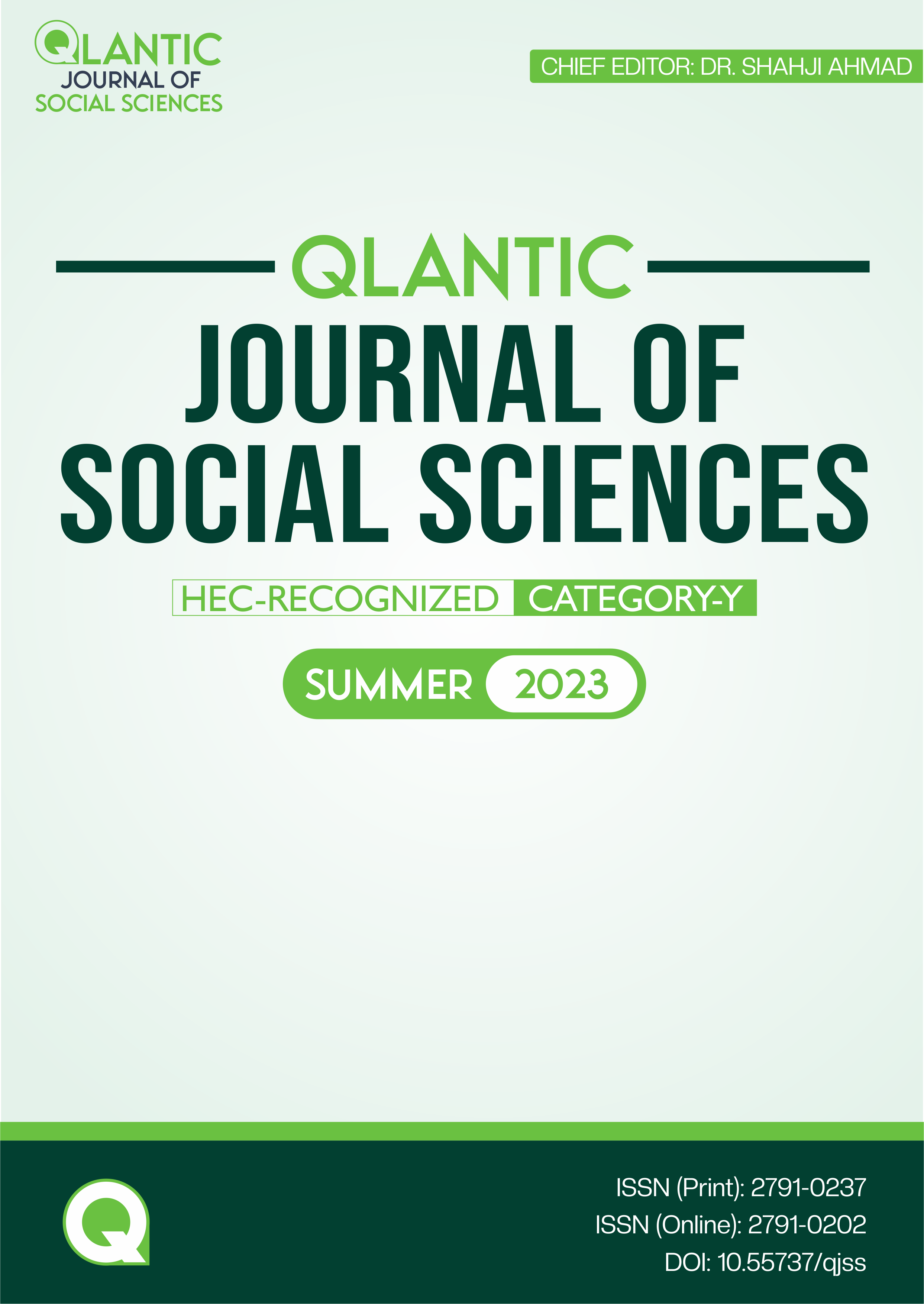Testing Club Convergence across Pakistan’s Districts by Using a Household Welfare Index
DOI:
https://doi.org/10.55737/qjss.528840207Keywords:
Household Welfare Index, Club Convergence, PCAAbstract
The study of club convergence has taken center stage in the literature on economic growth and development over the last three decades. GDP per capita has usually been employed as a proxy for the measurement of national welfare in studies of convergence in living standards across regions.The analysis is based on an augmented household welfare index for measuring household living standards through convergence and the clustering techniqueproposed by Phillips and Sul (2007). The index is composed of five indicators of household welfare. Using principal component analysis, the indicators are aggregated to get a final household welfare index.Overall, the findings of the studyreject the hypothesis that all districts of Pakistan converge to a unique equilibrium stateregarding the household welfare index. When club convergence was tested, five convergence clubs and one group of divergent districts were discovered.The findings show that there is not a uniform living standard across all districts, and thus, policies need to be designed to lessen these spatial disparities.
References
Aghion, P., & Howitt, P. W. (1997). Endogenous growth theory. National Geographic Books.
Azariadis, C. (1996). The economics of poverty traps part one: Complete markets. Journal of Economic Growth, 1(4), 449-486. https://doi.org/10.1007/bf00150197
Azariadis, C., & Drazen, A. (1990). Threshold externalities in economic development. The Quarterly Journal of Economics, 105(2), 501. https://doi.org/10.2307/2937797
Barro, R. J. (1992). Convergence. Journal of Political Economy, 100(2), 223-251. https://doi.org/10.1086/261816
Bartkowska, M., & Riedl, A. (2012). Regional convergence clubs in Europe: Identification and conditioning factors. Economic Modelling, 29(1), 22-31. https://doi.org/10.1016/j.econmod.2011.01.013
Basel, S., Gopakumar, K. U., & Prabhakara Rao, R. (2020). Testing club convergence of economies by using a broad-based development index. GeoJournal, 86(5), 2351-2365. https://doi.org/10.1007/s10708-020-10198-0
Chatterji, M. (1992). Convergence clubs and endogenous growth. Oxford Review of Economic Policy, 8(4), 57-69. https://doi.org/10.1093/oxrep/8.4.57
Córdoba, J. C., & Verdier, G. (2008). Inequality and growth: Some welfare calculations. Journal of Economic Dynamics and Control, 32(6), 1812-1829. https://doi.org/10.1016/j.jedc.2007.06.015
David, P. A. (1994). Why are institutions the ‘carriers of history’?: Path dependence and the evolution of conventions, organizations and institutions. Structural Change and Economic Dynamics, 5(2), 205-220. https://doi.org/10.1016/0954-349x(94)90002-7
Durlauf, S. N., & Johnson, P. A. (1995). Multiple regimes and cross-country growth behaviour. Journal of Applied Econometrics, 10(4), 365-384. https://doi.org/10.1002/jae.3950100404
Fleurbaey, M., & Blanchet, D. (2013). Beyond GDP. https://doi.org/10.1093/acprof:oso/9780199767199.001.0001
Fleurbaey, M., & Gaulier, G. (2009). International comparisons of living standards by equivalent incomes*. The Scandinavian Journal of Economics, 111(3), 597-624. https://doi.org/10.1111/j.1467-9442.2009.01578.x
Galor, O. (1996). Convergence? Inferences from theoretical models. The Economic Journal, 106(437), 1056. https://doi.org/10.2307/2235378
Hobijn, B., & Franses, P. H. (2000). Asymptotically perfect and relative convergence of productivity. Journal of Applied Econometrics, 15(1), 59-81. https://doi.org/10.1002/(sici)1099-1255(200001/02)15:1<59::aid-jae544>3.0.co;2-1
Krugman, P. (1991). Increasing returns and economic geography. Journal of Political Economy, 99(3), 483-499. https://doi.org/10.1086/261763
Li, F., Li, G., Qin, W., Qin, J., & Ma, H. (2018). Identifying economic growth convergence clubs and their influencing factors in China. Sustainability, 10(8), 2588. https://doi.org/10.3390/su10082588
Lucas, R. E. (1988). On the mechanics of economic development. Journal of Monetary Economics, 22(1), 3-42. https://doi.org/10.1016/0304-3932(88)90168-7
Mendoza-Velázquez, A., German-Soto, V., Monfort, M., & Ordóñez, J. (2019). Club convergence and inter-regional inequality in Mexico, 1940-2015. Applied Economics, 52(6), 598-608. https://doi.org/10.1080/00036846.2019.1659491
Nelson, R. R. (1993). National innovation systems: a comparative analysis. Oxford University Press, USA.
Phillips, P. C., & Sul, D. (2007). Transition modeling and econometric convergence tests. Econometrica, 75(6), 1771-1855. https://doi.org/10.1111/j.1468-0262.2007.00811.x
Quah, D. (1993). Galton's fallacy and tests of the convergence hypothesis. The Scandinavian Journal of Economics, 95(4), 427. https://doi.org/10.2307/3440905
Quah, D. T. (1996). Empirics for economic growth and convergence. European Economic Review, 40(6), 1353-1375. https://doi.org/10.1016/0014-2921(95)00051-8
Romer, P. M. (1986). Increasing returns and long-run growth. Journal of Political Economy, 94(5), 1002-1037. https://doi.org/10.1086/261420
Roy, H. (2009). Convergence of human development across Indian states. SSRN Electronic Journal. https://doi.org/10.2139/ssrn.1456755
Sen, A. (1983). Poor, relatively speaking. Oxford economic papers, 35(2), 153-169. https://doi.org/10.1093/oxfordjournals.oep.a041587
Solow, R. M. (1956). A contribution to the theory of economic growth. The Quarterly Journal of Economics, 70(1), 65. https://doi.org/10.2307/1884513
Tian, X., Zhang, X., Zhou, Y., & Yu, X. (2016). Regional income inequality in China revisited: A perspective from club convergence. Economic Modelling, 56, 50-58. https://doi.org/10.1016/j.econmod.2016.02.028
Venables, A. (1999). Regional integration agreements: A force for convergence or divergence? Policy Research Working Papers. https://doi.org/10.1596/1813-9450-2260
Zetterström, C., Olivestedt, G., & Lundvall, A. (2009). Exfoliation syndrome and extracapsular cataract extraction with implantation of posterior chamber lens. Acta Ophthalmologica, 70(1), 85-90. https://doi.org/10.1111/j.1755-3768.1992.tb02096.x




